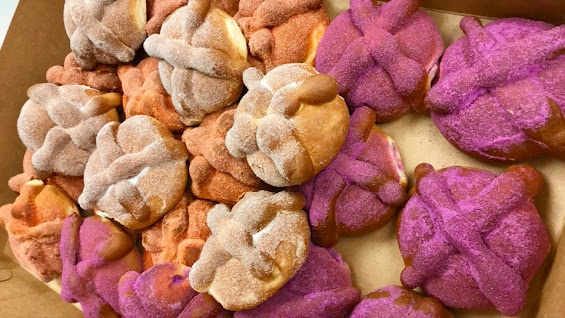The Day of the Dead and the Tradition of Pan de Muerto.
Carlota Roa @
When we think of the Day of the Dead in Mexico, the first things that come to mind are colorful altars, intricately decorated skulls, and, of course, the delicious *pan de muerto*. This bread, with its distinctive flavor and characteristic shape, is much more than just a food item; it symbolizes the connection between the living and the dead. This tradition has enriched over time and continues to be a fundamental part of the celebration.
Pan de muerto is a type of sweet bread baked especially for the Day of the Dead, celebrated on November 1 and 2. Its unmistakable shape is that of a round loaf topped with small balls of dough that symbolize the bones of the deceased. Each bite of this bread is a perfect combination of softness and sweetness, with hints of orange and anise that lend it a unique flavor.
The recipe varies slightly from region to region, but the basic ingredients include flour, sugar, yeast, butter, and eggs, along with a splash of orange blossom essence that gives it a special aroma. Most often, it is decorated with a sugar glaze that adds an extra touch of sweetness.
A Link to History and Culture
The origins of pan de muerto date back to pre-Hispanic times, although the modern form of the bread began to take shape with the arrival of the Spaniards and the blending of indigenous and European traditions. In pre-Hispanic cultures such as the Aztecs, ceremonies and offerings were already performed to honor the dead. With the arrival of the conquistadors, these rituals syncretized with Catholicism, leading to the celebration of the Day of the Dead as we know it today.
The incorporation of pan de muerto into this festivity is a clear example of how traditions evolve and adapt. It is believed that the bread as we know it began to be prepared in the 16th century, when the Spanish introduced wheat to Mexico. Over time, *pan de muerto* became an essential element of the altars, placed alongside photographs, flowers, candles, and other items to remember and honor loved ones who have passed.
Today, pan de muerto is enjoyed not only in Mexico but has also found its way to tables around the world. Bakeries and Mexican families strive to keep this tradition alive, preparing it with love and dedication. The recipe has been passed down through generations, and each family may have its special twist—whether it’s an extra layer of sugar, a unique blend of spices, or a special filling of cream or chocolate.
Moreover, pan de muerto has been reinvented in many modern forms, from innovative fillings to more stylized presentations. However, the meaning and essence of the bread remain the same. It is a celebration of life and death, a reminder that our loved ones never truly leave us, and that there is always a place for them at our tables and in our hearts.
Pan de muerto is more than just a sweet bread; it is a symbol of love, memory, and culture. Each time we see it on an altar, we are not just looking at a traditional sweet; we are participating in a celebration that unites families, generations, and cultures. Through this bread, we keep the memories of those who have departed alive and celebrate the richness of our cultural heritage. Thus, as we savor a piece of this sweet bread, we not only enjoy its flavor but also embrace the profound history and tradition it carries with it.
For more information, visit:
[www.carlotaroa.com](http://www.carlotaroa.com)
[www.spanishtodaytutoring.com](http://www.spanishtodaytutoring.com)




Comments
Post a Comment